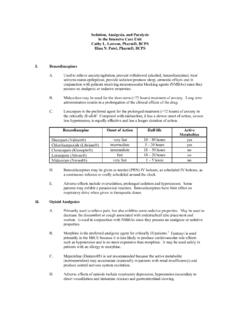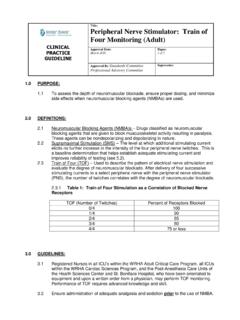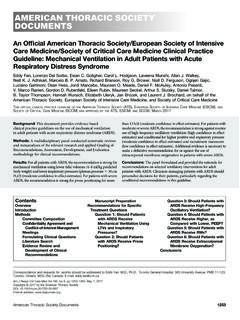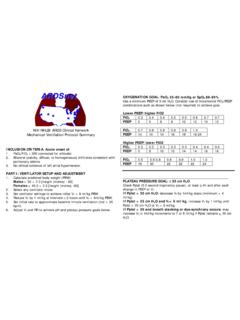Transcription of 14 WEEK NEW NURSING GRADUATE/NEW RN ORIENTATION …
1 1 14 WEEK NEW NURSING GRADUATE/NEW RN ORIENTATION PATHWAY Intensive care Unit Southern Ohio Medical Center ORIENTEE _____Date Started ____/____ /2019 Date Completed ____/____ /2019 Preceptor: _____Initials: _____ Preceptor: _____Initials: _____ Preceptor: _____Initials: _____ Preceptor: _____Initials: _____ Clinical Nurse Educator: _____Initials: _____ Nurse Manager: _____Initials: _____ The Pathway serves as a guide to your ORIENTATION . It will not always be possible to achieve week by week as written. It may not be possible to get all types of patients, skills, etc.
2 , within the ORIENTATION period. Please utilize the following to facilitate your ORIENTATION progress: critical care ORIENTATION notebook Hospital procedures and protocols (Intranet & Elsevier Clinical Skills) AACN s Core Curriculum for critical care Text Book In-house Classes as offered Nurse Manager: Ronda Wyant, BSN, RN & Kim Lester, BSN, RN Clinical Nurse Educator: Korina Eichenlaub, BSN, RN, CCRN Level I Basic ORIENTATION Benner s Stage 1: Novice (No Experience) The novice nurse has no experience of any situation in which they are expected to perform.
3 Novices are taught rules (policy and procedures) to help them perform. Defining Characteristics They are learning objective information, with tasks being broken down into steps. Knowledge is context-free and can be understood without experience. Practice is based on theoretical knowledge, rules and procedures. Rules are used to determine actions that are limited and inflexible. They are dependent on and have total confidence in those with greater expertise. They have an inability to use discretionary judgment. Level II Unit ORIENTATION Benner s Stage 2: Advanced Beginner The advanced beginner can demonstrate marginally acceptable performance based on experience.
4 Defining Characteristics Work is shaped by concern to organize, prioritize, and complete tasks. They perceive clinical situations as a set of tasks that must be completed. Attention and energies are focused on an inventory of things to do, all which are relevant. Assessments are more a task rather than a structure to direct clinical care . Patients appear as a perplexing collection of problems/conditions; absorbed in biological needs and feel unable to attend to psychosocial needs of patients/family. They respect and rely on judgment of nurse experts and defer complex clinical observations and decision making to those with greater expertise.
5 They are aware of their partial grasp; anxiety makes them more vigilant in their care . Precepting/mentoring is essential, it guides them as they fit the disjointed pieces together, seeing patterns, validating observations, weighing and balancing competing concerns, appreciating immense variation in individual responses and tailoring of care , and analyzing situations that did not go well. 2 **All items must be marked by the preceptor, Unit Manager, or Clinical Nurse Educator deeming the nurse competent or at least educated about that topic. Week 1 Patient Assignments Unit Activities Equipment Skills Should be receiving a variety of patient assignments.
6 Should not be the same from day to day unless good learning experiences. 1st Day: Shadow preceptor and complete Scavenger Hunt. Preceptor with patients. Then: ICU Orientee: 1 Patient Level 1 Preceptor: 1 patient Level 1/2 Meet Preceptor/s Define role and responsibilities of orientee and preceptor. Pyxis privileges/badge for med drawers/blood card signed (Educator assists) Scavenger Hunt Introduction to patient care . Role of critical care Educator Role of Assistant Nurse Manager critical care Physician/Provider Physical environment Location of emergency equipment / Fire Extinguisher Emergency Shut-off Valve for O2 Use of Telephones Bed Controls: Stryker Beds Pyxis System Use of Cardiac Monitors/Sp02 Monitoring Glucometer IV Pumps Review Basic Skills Assessment Cardiac Monitor & Lead Placement.
7 Using SOMC's Intranet Insertion of Peripheral IV's Assessment & Patient Management Documentation Policies / Procedures IV Therapy/ critical care Medications Routine HCU/ICU Assessment Pain Assessment Routine HCU/ICU patient care . Jet Forms: location & printing NURSING Progress Notes eMAR/POC RIDER Order critical care ORIENTATION checklist Patient Chart DNR Policies: cc verses cc arrest Completion of time card (API) Falls Risk Assessment Falls Risk: review & use of sign Locating SOMC Policies 1. Patient Rights 2. Safety /Infection Control 3.
8 Organization Wide 4. Department of NURSING Peripheral lines maintenance Administration of Antibiotics Administration of Electrolyte Replacement (RIDERS) Administration of IVP LINES: _____ ____/____ _____ ____/____ _____ ____/____ _____ ____/____ DRIPS: _____ ____/____ _____ ____/____ _____ ____/____ _____ ____/____ VENTILATION: _____ ____/____ _____ ____/____ _____ ____/____ _____ ____/____ Miscellaneous Experiences:_____ _____ Comments include the Type/Diagnosis of Patient Assignments, Strengths, Goals/Areas Requiring Reinforcement: Week 1 Patient 1:_____Patient 2:_____Patient 3:_____ Preceptor:_____ Orientee:_____ 3 Week 2 Patient Assignments Unit Activities Equipment Skills ICU Orientee: One Patient Level 1 Preceptor: 1 simple patient Patient care Routine Room Layout Room Stock Material Management Supply Room Tube System.
9 Hyper-/Hypothermia Machine Oxygen Outlets Wall Suctions Dopplers Basic EKG Assessment/ Interpretation Central Lines: Setup/Protocol/Procedure CVP Monitoring Pressurized Tubing System for Hemodynamics (CVP/Swan/Aline) Assessment & Patient Management Documentation Policies / Procedures IV Therapy/ critical care Medications Cardiovascular assessment Normal Heart Sounds Unstable Angina/ Acute Coronary Synd. Acute MI: Inferior, Anterior, Septal, Lateral, Right Ventricular, Non Q Wave CHF/Pulmonary Edema NURSING Admission Data Base Implementation of protocols.
10 POCs & NURSING documentation Heparin protocol/Anticoagulant documentation Insulin drip Flow Sheet Discharge forms Noting Physician Orders Physician On call & notification Surgical / Procedure Consents Time Out / Site Verification procedure Infusing Multiple IV s Heparin protocol Nitroglycerin Pain Medications/Management PRBC/FFP/Cryo/Platelets Administration Fluid Boluses LINES: _____ ____/____ _____ ____/____ _____ ____/____ _____ ____/____ DRIPS: _____ ____/____ _____ ____/____ _____ ____/____ _____ ____/____ VENTILATION: _____ ____/____ _____ ____/____ _____ ____/____ _____ ____/____ Miscellaneous Experiences:_____ _____ Comments include the Type/Diagnosis of Patient Assignments, Strengths, Goals/Areas Requiring Reinforcement: Week 2 Patient 1:_____Patient 2:_____Patient 3:_____ Preceptor:_____ Orientee:_____ 4 Week 3 Patient Assignments Unit Activities Equipment Skills ICU Orientee: One Patient Level 1 or 2 Preceptor.






